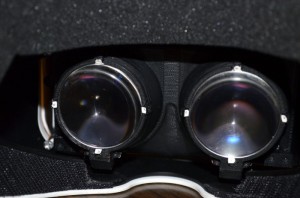Hands-on: FOVE’s Eye-tracking VR Headset Was the Next Best at CES
 While the latest FOVE prototype looks similar on the outside, it’s using totally different display tech: currently a single 1440p LCD panel with a field of view that felt like it matched that of the Oculus Rift DK2. Though the current prototype lacks positional tracking (the ability to track the head through 3D space), the rotational tracking felt better than every other new VR headset I tired at CES, save for the Oculus Rift Crescent Bay prototype. It’s good to see that they’re focused on latency, because it’s the keystone that many entrants to the consumer VR headset market are currently lacking.
While the latest FOVE prototype looks similar on the outside, it’s using totally different display tech: currently a single 1440p LCD panel with a field of view that felt like it matched that of the Oculus Rift DK2. Though the current prototype lacks positional tracking (the ability to track the head through 3D space), the rotational tracking felt better than every other new VR headset I tired at CES, save for the Oculus Rift Crescent Bay prototype. It’s good to see that they’re focused on latency, because it’s the keystone that many entrants to the consumer VR headset market are currently lacking.
On top of a 1440p display, solid headtracking, and an a decent field of view, FOVE’s real trick is its ability to track the wearer’s eyes.
Inside the headset, each lens is surrounded on the top, bottom, left, and right with IR LEDs which illuminate the eye, allowing cameras inside to detect the orientation of each. Looking through the lenses looks just like you’d expect from a VR headset without eye-tracking; Wilson told me that this is different from other VR headset eye-tracking solutions, which can have components that obscure parts of the field of view.
As it stands, FOVE is putting a fair amount of emphasis on the ability to aim with your eyes (probably because it’s easy to show and easy to understand), but to me that’s a red herring; what excites me about eye-tracking are the more abstract and enabling possibilities like eye-based interface and contextual feedback, simulated depth-of-field, foveated rending, and avatar eye-mapping.
See the full story, with expanded explanations of eye-based interface and contextual feedback, simulated depth-of-field, foveated rending, and avatar eye-mapping, here: http://www.roadtovr.com/fove-eye-tracking-vr-headset-hands-on-ces-2015/
Pages
- About Philip Lelyveld
- Mark and Addie Lelyveld Biographies
- Presentations and articles
- Tufts Alumni Bio